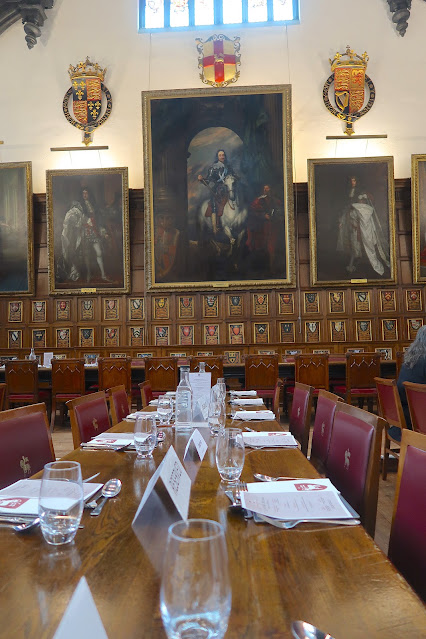
The Inns of Court in London are the professional associations for barristers in England and Wales. There are four Inns of Court: Gray's Inn, Lincoln's Inn, Inner Temple and Middle Temple. All barristers must belong to one of them. First and foremost, Middle Temple is one of the four Inns of Court which have the exclusive right to Call students to the Bar, running of a modern Law library and an historic archive, and also oversight — with Inner Temple — of the historic Temple Church, which is steeped in history. Built in 1162 built by the Knights Templar, Temple Church is also known as ‘the mother-church of the Common Law’. It played a central role in the gestation of Magna Carta, and in the spread of the Charter’s principles to America and throughout the world. William Marshal, 1st Earl of Pembroke, son-in-law of Strongbow and Aoife Mac Murrough, and hero of Runnymede, is buried in the church, as is his son the 2nd earl, one of Magna Carta’s surety barons. Issued in 1215, the Magna Carta was the first document to put into writing the principle that the king and his government was not above the law. It sought to prevent the king from exploiting his power, and placed limits of royal authority by establishing law as a power in itself. Spending the morning exploring Temple Church and the beautiful architecture and gardens within the Inns of Court, we had made lunch reservations at Middle Temple largely due to our dear friend Jean Downey's recommendation, and so glad we did.
Built during the reign of Elizabeth I, Middle Temple Hall is one the finest examples of an Elizabethan architecture in London, spanned by a magnificent double hammerbeam roof — the best in London — and stained glass windows which display the coats of arms of distinguished members, including Walter Raleigh. Built in 1573, Middle Temple Hall just celebrated its 450th anniversary. It’s also where Shakespeare held the premiere of his Christmas play, Twelfth Night, in 1602. The head table at the end of the hall was carved out of a single oak, floated down the Thames from Windsor on the orders of Elizabeth I. Above the head table are a series of spectacular oil paintings including is a large painting of King Charles I, Charles II, James II, William III, Elizabeth I, Queen Anne and George I. Along the walls are panels bearing the coats of arms of senior and current members dating back to 1597. Dining amid such Elizabethan grandeur with members of the Inns of Courts, we enjoyed a lovely lunch beginning with a glass of wine, homemade bread and butter, silky smooth Tomato and White Bean Soup followed by hand carved Roast Pork, roasted potatoes and sautéed courgettes. A wonderful lunch, with gracious and courteous staff, in a truly remarkable setting. Another one of Londons hidden gems.

Tucked away down the cobbled Middle Temple Lane, Fountain Court is a calm oasis
The fountain for which Fountain Curt is named
Nestled in perfectly preserved courtyards, chapels and libraries, many of the buildings remain unchanged since medieval times Temple Church and the Inns of Court are a hidden gem
The secret vegetable and cutting garden behind the Church of the Knights' Templar
The remarkable West Porch of Temple Church was built around 1160
The Temple Church was built by the Knights Templar in the 12th century and the round tower was consecrated by Heraclius, the Patriarch of Jerusalem in 1185
The design of the round tower was intended to resemble the Church of the Holy Sepulchre in Jerusalem, and curiously was featured in Dan Brown's Da Vinci Code
I climbed the steep spiral stone staircase to the 2nd floor for an interior view
over the Round Tower of Temple Church
Overlooking the round nave with effigies of knights
Burials in the Temple Church include William Marshal, 1st Earl of Pembroke, championed the Magna Carta at Runnymede in 1215
Copy off the Magna Carta which was the first document to put into writing
the principle that the king and his government was not above the law
The rectangular Chancel of Temple Church, consecrated in 1240, was originally built to accommodate Henry III's wish to be buried there, but was eventually buried in Westminster Abbey
Book of Common Prayer and Bible laid out for Choral Evensong
Entrance to historic Middle Temple Hall, one of the finest Elizabethan Halls in London
Coats of arms cover the wood-panelled walls and represent past members of Middle Temple, providing a historic backdrop for our special lunch
Dining under the spectacular double hammerbeam roof that dates back to 1573, the hall is an Elizabethan masterpiece which has survived the Fire of London and two World Wars.
We sat overlooking the high table which was donated by Elizabeth I and made of Tudor oak
Equestrian portrait of King Charles I, after Van Dyck
Our reserved seating at Middle Temple
The lunch menu changes every day and features 2 or 3 courses with 3 entrée options and a hot or cold dessert
Glass of Middle Temple Claret
Complimentary Bread and Butter
Roasted Tomato and White Bean Soup
Lunch is buffet style, with a set menu for groups larger than 6, with a selection of champagne, wine or beer served by attentive wait staff
The gentleman in black oversees the Carvery which features a different roast every day
The Carvery entrée of the day was Porchetta which is hand carved and served with homemade apple sauce
A selection of potatoes and seasonal vegetables are served as a buffet including other entrées including Chicken Milanese and Vegetarian Harisssa Glazed Aubergine
Porchetta with roast potatoes and courgettes
Chocolate Mousse with grilled orange
A combination of barristers and visitors dine for lunch which is served 12-2pm
Shakespeare's Twelfth Night was famously performed at the Middle Temple on 2 February 1602




































































